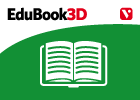Cargando...
Recursos educativos
-
Nivel educativo
-
Competencias
-
Tipología
-
Idioma
-
Tipo de medio
-
Tipo de actividad
-
Destinatarios
-
Tipo de audiencia
-
Creador
Lo más buscado
- Árbol genealógico
- Aprender inglés en tercero
- Júpiter
- Experimentos naturales
- Actividades de lógica en cuarto
- Repaso biología bachillerato
- Juegos de tablas de multiplicar segundo
- Actividades didacticas en primero
- Experimentos de ciencias para P4
- Actividades educativas para niños en tercero
- Aprender inglés en primero
- Construcciones dinámicas con regla y compás
- Experimentos de ciencias para tercero
- Arte bizantino para primero
- Niños y salud
-

Remember - Human beings
EduBook Organización
- 6075 visitas
Human beings look different from each other. But human beings are also similar in many ways. Our bodies have three parts: the head, the torso and the limbs. We use our motor system to move. Our motor…
-

Introduction - Human beings
EduBook Organización
- 6009 visitas
Human beings look different from each other. But human beings are also similar in many ways. Our bodies have three parts: the head, the torso and the limbs. We use our motor system to move. Our motor…
-

Activities - Human beings
EduBook Organización
- 5964 visitas
Human beings look different from each other. But human beings are also similar in many ways. Our bodies have three parts: the head, the torso and the limbs. We use our motor system to move. Our motor…
-

Echinoderms
EduBook Organización
- 2998 visitas
3.1. Echinoderms Echinoderms are animals that live at the bottom of the sea. They do not have a head. They have an external skeleton consisting of plates with spines. The majority of echinoderms have a…
-

The bones of the head and the torso
EduBook Organización
- 1 lo usan
- 2712 visitas
Bones of the head The bones of the head form the skull. It has two parts: the cranium and the facial bones. The cranium The cranium is a closed cavity that protects one of the most delicate organs in…
-

Observe. Development of an embryo
EduBook Organización
- 2849 visitas
The photos show the development of a chicken embryo. The embryo develops until it becomes a chick. It then hatches from the egg. At 5 days, there are thin red blood vessels that extend from the embryo,…
-

Video game: Electrocardiogram
Tiching explorer Organización
- 3883 visitas
This game explores the key elements of the electrocardiogram, from how and where to place the electrodes (practicing body parts) to how to analyze the mountains and valleys in the ECG curve. We have to…
-

Correct. Bones
EduBook Organización
- 2539 visitas
Correct the underlined words in this text. Write the correct words in the space: Bones are the softest parts of the body. They are made of cartilage tissue which contains lots of blood vessels . Bones…
-

What are our teeth made of?
EduBook Organización
- 2186 visitas
Each tooth is divided into two parts: the crown, which we can see, and the root, which is fixed into the jaws. The centre of the tooth contains blood vessels and nerves, which allow us to feel pain.…
-

Vocabulary (KET)
EduBook Organización
- 1349 visitas
Read the descriptions below. What is the word for each one? The first letter is already there. There is one space for each other letter in the word. Something that is impossible to understand. m You…
Te estamos redirigiendo a la ficha del libro...












